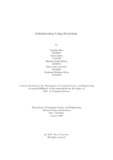| dc.contributor.advisor | Monim, Mobashir | |
| dc.contributor.author | Bose, Anindita | |
| dc.contributor.author | Islam, Raima | |
| dc.contributor.author | Safrina, Sikander Sofia | |
| dc.contributor.author | Bin Khurshid, Dishari | |
| dc.contributor.author | Khan, Mashequr Rahman | |
| dc.date.accessioned | 2023-08-14T04:32:23Z | |
| dc.date.available | 2023-08-14T04:32:23Z | |
| dc.date.copyright | 2023 | |
| dc.date.issued | 2023-01 | |
| dc.identifier.other | ID: 22341067 | |
| dc.identifier.other | ID: 22341060 | |
| dc.identifier.other | ID: 22341074 | |
| dc.identifier.other | ID: 21141082 | |
| dc.identifier.other | ID: 22341068 | |
| dc.identifier.uri | http://hdl.handle.net/10361/19394 | |
| dc.description | This thesis is submitted in partial fulfillment of the requirements for the degree of Bachelor of Science in Computer Science, 2023. | en_US |
| dc.description | Cataloged from PDF version of thesis. | |
| dc.description | Includes bibliographical references (pages 50-52). | |
| dc.description.abstract | While password-based authentication is widely used by many applications today, it
has grave vulnerabilities that can make our devices and accounts prone to malicious
attacks. 2-factor authentication (2FA) and Multi-factor authentication (MFA) were
introduced to increase the security of the generic password-based authentication
and they did enhance the security of the credential-based system by using second
or multiple factors to provide additional security. However, even though the intro duction of the second factor increased the security, this approach has weaknesses
as well: there are many methods through which a hacker can get access to our do main, such as SIM swap hacking, phishing attacks, ambush attacks during password
recoveries, or One Time Password (OTP)-based attacks. Instead of addressing the
security problems of 2FA or MFA, we aim to strengthen the security of the generic
password-based authentication system by adding a layer of security to the existing
first factor. In this process, the user will log in using their credentials and on suc cessful verification of the password, the blockchain-based authentication will begin.
Lastly, the Di | en_US |
| dc.description.statementofresponsibility | Anindita Bose | |
| dc.description.statementofresponsibility | Raima Islam | |
| dc.description.statementofresponsibility | Sikander Sofia Safrina | |
| dc.description.statementofresponsibility | Dishari Bin Khurshid | |
| dc.description.statementofresponsibility | Mashequr Rahman Khan | |
| dc.format.extent | 52 pages | |
| dc.language.iso | en | en_US |
| dc.publisher | Brac University | en_US |
| dc.rights | Brac University theses are protected by copyright. They may be viewed from this source for any purpose, but reproduction or distribution in any format is prohibited without written permission. | |
| dc.subject | Blockchain | en_US |
| dc.subject | Authentication | en_US |
| dc.subject | Security | en_US |
| dc.subject | Hash | en_US |
| dc.subject | Nonce | en_US |
| dc.subject | Diffie-Hellman | en_US |
| dc.subject.lcsh | Blockchains (Databases)--Security measures. | |
| dc.title | Authentication using blockchain | en_US |
| dc.type | Thesis | en_US |
| dc.contributor.department | Department of Computer Science and Engineering, Brac University | |
| dc.description.degree | B. Computer Science | |

